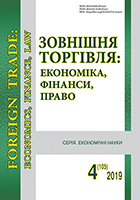Determinants for the demographic sustainability ensuring
DOI:
https://doi.org/10.31617/zt.knute.2019(105)04Keywords:
demographic stability, institutional mechanisms and tools, , demographic burden, synergistic effectAbstract
Background. Taking the peculiarities of emerging economies into account, the complex nature of demographic sustainability involves a number of methodological approaches to determine the composition of relevant environment, outlining the interaction between its elements. Strategic management, based on the coordination of the sustainability’s determinants, induces positive synergies that ensure permanent endogenous economic growth.
The aim of the article is to develop the methodological bases for demographic stability, to systematize comprehensively the tools for its provision under current conditions of economic transformations.
Materials and methods. The research is based on the scientific works on the problem under consideration. Both the object’s and the subject’s features caused the integrated application of methods and approaches that ensured the study’s conceptual unity. Systemic, institutional and dialectical approaches, methods of comparative analysis and synthesis, generalization, scientific abstraction have been applied.
Results. Demographic sustainability should be assessed regarding a set of natural determinants and human migration as well. Moreover, migration could in its own particular way compensate for depopulation. Demographic sustainability and economic growth are achievable with the optimum combination of natural and migration factors.
Conclusion. The means of authorities’ influence both on society’s behavior and forms of its self-organization are represented by ensuring tools for demographic sustainability. Public administration institutions use fiscal, monetary, social, and innovation-investment mechanisms to establish demographic sustainability, considering the principles of scientific validity, versatility of action, economic efficiency, multidimensionality, complexity, financial inclusion, reconciliation of individual and collective interests, social justice and partnership, solidarity and responsibility. Informal factors also play an important role. Other economic agents should also adhere to those principles, maximizing positive synergy.
References
McGrattan, E. R., & Prescott, E. C. (2018). An aggregate model for policy analysis with demographic change. The Journal of the Economics of Ageing, 11, 52-61. DOI: https://doi.org/10.1016/j.jeoa.2017.01.001 [in English].
Cordoba, J. C., & Liu, X. (2016). Stochastic dominance and demographic policy evaluation: a critique. Journal of Demographic Economics, 82 (1), 111-138. DOI: https://doi.org/10.1017/dem.2016.1 [in English].
Wynne, M. (2016). Global demographic trends shape policy environment. Economic Letter, 11 (7), 1-4 [in English].
Libanova, E. M. (2016). Innovacijni vazheli demografichnoi' polityky [Innovative levers of demographic policy]. Problemy innovacijno-investycijnogo rozvytku [Problems of innovation and investment development], 9, 21-33. Serija: Ekonomika ta menedzhment [in Ukrainian].
Ljubohynec', L. S. (2017). Upravlinnja ljuds'kym kapitalom v umovah innovacijnogo ekonomichnogo rozvytku: svitova ta nacional'na praktyka [Human capital management in the context of innovative economic development: world and national practice]. Visnyk Hmel'nyc'kogo nacional'nogo universytetu – Bulletin of the Khmelnytsky National University, 2 (1), 7-14 [in Ukrainian].
Lisnichuk, O. A. (2018). Instytucional'ni chynnyky zabezpechennja regional'nogo rozvytku [Institutional factors for regional development]. Naukovi zapysky Nacional'nogo universytetu «Ostroz'ka akademija» – Scientific notes of the National University of Ostroh Academy, 8 (36), 53-57. Serija «Ekonomika». DOI: https://doi.org/10.25264/2311-5149-2018-8(36)-53-57 [in Ukrainian].
Maslow, A. H. (1943). A theory of human motivation. Psychological review, 50 (4), 370. DOI: https://doi.org/10.1037/h0054346 [in English].
Pigou, A. C. (1951). Some aspects of welfare economics. The American Economic Review, 41 (3), 287-302 [in English].
Nordhaus, W. D., & Tobin, J. (1972). Is growth obsolete? In Economic Research: Retrospect and prospect. (Vol. 5). Economic growth (pp. 1-80). Nber [in English].
Samuelson, P. A. (1976). The optimum growth rate for population: Agreement and evaluations. International Economic Review, 516-525. DOI: https://doi.org/10.2307/2525721 [in English].
Deardorff, A. V. (1976). The optimum growth rate for population: comment. International Economic Review, 510-515. DOI: https://doi.org/10.2307/2525720 [in English].
Abio, G. (2003). Interiority of the optimal population growth rate with endogenous fertility. Documents de treball (Facultat d'Economia i Empresa. Espai de Recerca en Economia). E03/096 [in English].
Bernheim, B. D. (2010). Behavioral welfare economics, Panoeconomicus, Savez ekonomista Vojvodine, 57 (2), 123-151. DOI: https://doi.org/10.2298/PAN1002123B [in English].
Beets, G., & Willekens, F. (2009). The global economic crisis and international migration: An uncertain outlook. Vienna Yearbook of Population Research, 1-14. DOI: https://doi.org/10.1553/populationyearbook2009s19 [in English].
Barro, R. J., & Sala-i-Martin, X. (1992). Convergence. Journal of political Economy, 100 (2), 223-251. DOI: https://doi.org/10.1086/261816 [in English].
Barro, R. J. (1997). Determinants of Economic Growth: A Cross-Country Empirical Study. MIT Press Books. The MIT Press, the 1st ed. (Vol. 1). DOI: https://doi.org/10.3386/w5698 [in English].
Barro, R. J., & Sala-i-Martin, X. (2003). Economic growth (2nd ed.). Massachusetts: MIT Press [in English].
Chugunov, I., & Pasichnyi, M. (2018). Fiscal stimuli and consolidation in emerging market economies. Investment Management and Financial Innovations, 15 (4), 113-122. DOI: https://doi.org/10.21511/imfi.15(4).2018.09 [in English].
Tiebout, C. M. (1956). A pure theory of local expenditures. Journal of political economy, 64 (5), 416-424. DOI: https://doi.org/10.1086/257839 [in English].
Crowe, C. & Meade, E. (2008). Central bank independence and transparency: Evolution and effectiveness. European Journal of Political Economy, 24 (4), 763-777. DOI: https://doi.org/10.1016/j.ejpoleco.2008.06.004 [in English].
Sims, C. A. (2013). Paper money. American Economic Review, 103 (2), 563-84. DOI: https://doi.org/10.1257/aer.103.2.563 [in English].
Additional Files
Published
How to Cite
Issue
Section
License
Copyright (c) 2022 Foreign trade: Economics, Finance, Law

This work is licensed under a Creative Commons Attribution 4.0 International License.
This work is licensed under a Creative Commons Attribution 4.0 International (CC BY 4.0)







